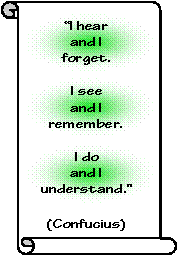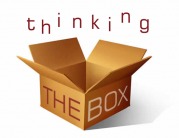Welcome!
We would like to welcome you to our blog entry. Our group looked into Project-Based Learning (PBL), and how it can be used in online education. Whether you're a teacher using PBL in your classes, a student who has done project-based assignments, or just curious or interested in learning more about PBL...Let's talk PBL!
What is PBL all about?

Project-Based Learning (PBL) is nothing new. In fact most of us have probably experienced PBL in some way or form whether as students or teachers. PBL is a learner-centered instructional strategy in which students work cooperatively over time to create a product, presentation, or performance. PBL is rooted in constructivism, the educational theory in which emphasis is placed on the learner, and the belief that students learn through their experiences...by doing. In PBL, students work
collaboratively to construct their own knowledge.
More specifically, PBL is defined by the Buck Institution of Education as “a systematic teaching method that engages students in learning essential knowledge and life-enhancing skills through an extended, student-influenced inquiry process structured around complex, authentic questions and carefully designed products and task.”
Benefits of PBL

PBL has been around for over a century, and there have
been numerous studies and reports written in support of
using project-based curriculums. PBL has been proven
to be an effective instructional strategy that can be implemented at all educational levels, and in all disciplines. The Intel® Teach Program is a program that provides training for K-12 teachers on how to integrate technology into their lessons in order to promote problem solving, critical thinking and collaboration skills among
their students.
On their Web site, The Intel® Teach Program discusses PBL in depth and list the following as
benefits of using PBL:
ü Promotes the learning and application of problem solving, communication, and
self-management skills.
ü Supports lifelong learning, civic responsibility, and personal/career success.
ü Assesses performance on content and skills using criteria similar to those found in the
work world.
ü Creates positive communication and collaborative relationships among diverse groups.
ü Addresses varying skill levels and learning styles.Program Web site, click on
the link below.
http://www97.intel.com/en/ProjectDesign/Design/
Also available on the Intel® Teach Program Web site, is a four page PDF article that provides a good overview of PBL, discusses its benefits, as well as presents challenges teachers face in implementing PBL. This article also concludes with a resource and reference list for more information about PBL. http://download.intel.com/education/Common/en/Resources/DEP/projectdesign/DEP_pbl_research.pdf
General Characteristics of PBL

While there are many ways in which to incorporate PBL into curriculums, and there is no one "right" way to implement PBL. Many factors can play into the design of a project-based assingment, but in comparing various reports and studies there seems to be a general consensus of what constitutes a well-designed project.
In effective projects:
ü students are engaged in open-ended, authentic tasks.
ü projects are driven by curriculum-framing questions.
ü the levels of student control and teacher-planned structure that guides and focuses some
control student work are well balanced.
ü decisions about how they complete project tasks are turned over to students, while
teachers take on the role of a facilitator or coach.
ü students work collaboratively, taking on roles that best suit their individual talents.
ü learning objectives are clearly defined, and are aligned with standards.
ü on-going and multiple types of assessments are used to evaluate learning.
ü are relevant to students' lives and are connected to the real world.
ü require students to demonstrate their knowledge through a product or performance.
Examples
Here are two examples of PBL currently being implemented in Hawaii!
The first is a project being done at Nuuanu Elementary, and the second is a project being done at Moanalua High School, both on Oahu. As you will see, PBL can be used effectively with all age groups, even down to kindergarten-aged students. As you watch the videos, take special notice of the elements of good project design listed in the section above. You can find out more about these projects at Edutopia (Nuuanu Elementary, Moanalua High School)
Using PBL in online education

With the rapid development of new technologies and the recent push to integrate technology into education, teachers are beginning to use more and more technology in their classrooms. The videos above are good examples of the use of technology and PBL. PBL works well with technology. In addition,the Internet and Web can provide students in traditional face-to-face classrooms with a lot of resource information for projects.
Additionally, PBL is also being used more and more in online education. Research indicates an effective strategy to promote learning in an online environment is to employ collaborative learning, and PBL is well suited to collaborative learning. PBL is student-centered, hands-on, and interactive. And rather than disseminating information through direct instruction, the instructor's role becomes more of a facilitator, providing guidance and support through the learning experience.
Of course, implementing PBL online presents its own set of challenges. As one researcher stated, “putting stuff online is easy—creating an online learning experience is hard.” Some of the particular
challenges instructors may face when incorporating PBL online include:
ü engaging students
ü ensuring sufficient level of participation and interaction
ü ensuring students have the technology and skills needed to utilize communication and
collaboration tools
ü formation of a learning community
However, with the proper planning, PBL can be implemented effectively online. Things instructors can do to address these challenges are to research and use appropriate online tools, promote the forming of a strong learning community, and provide adequate support and guidance to students.
Additional tools and resources

Let's Talk PBL
http://www2.hawaii.edu/~jhomori/PBL_index.html
A Web-based learning object we created about PBL for our ETEC 649:Designing
Online Courseware class. This Web site was designed with teachers in mind,
includes background information about PBL, a how-to section discussing how to
design a project, as well as tools and resources to get a project "off the ground."

PBL-Online
http://pbl-online.org/
A one stop solution for Project Based Learning including information and resources to
design and manage high quality projects for middle and high school students. Includes
a video library (http://pbl-online.org/video/video.htm) that has videos relating to each
step of the design process.

Project Based Learning Handbook
http://www.bie.org/pbl/pblhandbook/contents.php
Buck Institute of Education's comprehensive overview of PBL provides a detailed
planning model for teachers and PBL research.

Edutopia
http://www.edutopia.org/teaching-module-pbl
Project-Based Learning teaching module is designed for either a two- to three-hour
class or session or a one- to two-day workshop, and is divided into two parts. A lot
of information, articles, and videos.

ICT-Assisted Project-Based Learning
http://www.uoregon.edu/~moursund/PBL/index.html
Created by David Moursund this Web site is designed to support a workshop, a
short course, or self study on Information and Communication Technology
(ICT)-Assisted Project-Based Learning. There are enough materials for a two-day
workshop or a one-credit course.
Conclusion
Conducting class projects is nothing new in education. However, PBL is much more than just a time-filler, or a fun class activity. PBL has much more to offer, and has been proven to be a legitimate teaching strategy with many strengths and benefits. The effective use of PBL will not only result in the learning of the subject matter; it will also help develop in our students the collaborative and communication skills they will need in order to be successful citizens and workers in the 21st century.
Whether you're a teacher interested in or already using PBL in your classes, or a student who has done project-based assignments we'd love to hear from you. If you have questions, comments or would like to share your experiences with PBL, you can post a comment by clicking "comments" at the top of this page and completing the "Leave a Reply" form.
For teachers who have done PBL before:
What elements would you always include in your projects?
What are some "lessons learned" from doing these projects?
What advice would you offer other teachers interested in doing PBL?
For students who have done projects for a class:
Describe a memorable project you have done before.
What about the project made it memorable?
What did you like and dislike about doing that project?


 RSS Feed
RSS Feed